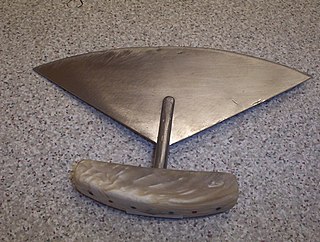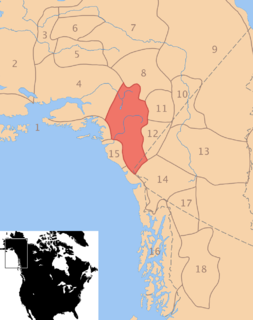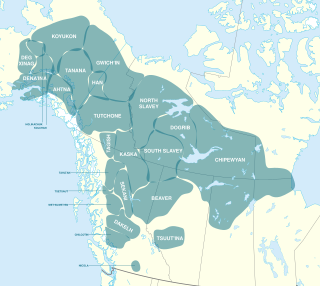
The Yukon River is a major watercourse of northwestern North America. The river's source is in British Columbia, Canada, from which it flows through the Canadian Yukon Territory. The lower half of the river lies in the U.S. state of Alaska. The river is 3,190 kilometres (1,980 mi) long and empties into the Bering Sea at the Yukon–Kuskokwim Delta. The average flow is 6,430 m3/s (227,000 ft3/s). The total drainage area is 832,700 km2 (321,500 mi2), of which 323,800 km2 (126,300 mi2) is in Canada. The total area is more than 25% larger than Texas or Alberta.

Grayling is a city in Yukon-Koyukuk Census Area, Alaska, United States. At the 2010 census the population was 194, unchanged from 2000. Since 1977, the Athabaskan village has seen a surge of interest on odd-numbered years, when it is the site of a checkpoint during the Iditarod Trail Sled Dog Race. It is situated after the checkpoint at Anvik and before Eagle Island.

Athabaskan is a large family of indigenous languages of North America, located in western North America in three groups of contiguous languages: Northern, Pacific Coast and Southern. Kari and Potter 2010:10 place the total territory of the 53 Athabaskan languages at 4,022,000 square kilometres (1,553,000 sq mi).

Alaska Natives or Alaskan Natives are indigenous peoples of Alaska, United States and include: Iñupiat, Yupik, Aleut, Eyak, Tlingit, Haida, Tsimshian, and a number of Northern Athabaskan cultures. They are often defined by their language groups. Many Alaska Natives are enrolled in federally recognized Alaska Native tribal entities, who in turn belong to 13 Alaska Native Regional Corporations, who administer land and financial claims.

The Iditarod River is a 325-mile (523 km) tributary of the Innoko River in the U.S. state of Alaska. The river begins north of Chuathbaluk and the Russian Mountains and flows northeast and then west to meet the larger river near Holikachuk.

An ulu is an all-purpose knife traditionally used by Inuit, Yupik, and Aleut women. It is utilized in applications as diverse as skinning and cleaning animals, cutting a child's hair, cutting food, as a weapon and, if necessary, trimming blocks of snow and ice used to build an igloo.

Deg Hitʼan is a group of Yupikized Athabaskan peoples in Alaska. Their native language is called Deg Xinag. They reside in Alaska along the Anvik River in Anvik, along the Innoko River in Shageluk, and at Holy Cross along the lower Yukon River.

Holikachuk are a Yupikized Alaska Native Athabaskan people of the Athabaskan-speaking ethnolinguistic group to western Alaska. Their native territory includes the area surrounding the middle and upper Innoko River. Later in 1963 they moved to Grayling on the Yukon River.

Northern Athabaskan is a geographic sub-grouping of the Athabaskan language family spoken by indigenous peoples in the northern part of North America, particularly in Alaska, the Yukon and the Northwest Territories. The Northern Athabaskan languages consist of 31 languages that can be divided into seven geographic subgroups.
Holikachuk was an Athabaskan language formerly spoken at the village of Holikachuk (Hiyeghelinhdi) on the Innoko River in central Alaska. In 1962, residents of Holikachuk relocated to Grayling on the lower Yukon River. Holikachuk is intermediate between the Deg Xinag and Koyukon languages, linguistically closer to Koyukon but socially much closer to Deg Xinag. Though it was recognized by scholars as a distinct language as early as the 1840s, it was only definitively identified in the 1970s. Of about 180 Holikachuk people, only about 5 spoke the language in 2007. In March 2012, the last living fluent speaker of Holikachuk "died" in Alaska.

As of 2017, Alaska has an estimated population of 739,818.
James Kari is a linguist and Professor Emeritus with the Alaska Native Language Center at the University of Alaska Fairbanks (UAF) specializing in the Dene of Alaska. In the past forty-five years he has done extensive linguistic work in many Dene languages including Ahtna, Dena'ina, Koyukon, Deg Hit'an, Holikachuk, Lower Tanana, Middle Tanana, Tanacross, Upper Tanana, and Babine-Witsuwit'en. He was on the faculty of UAF from 1973 until his retirement in 1997. He continues to work on numerous Alaska Native language projects. He is the author or editor of over 200 publications, including more than 4000 pages of bilingual texts in seven Dene languages. He is the most prolific contributor to the Alaska Native Language Archive. His special interest is Dene ethnogeography, and he has compiled or documented more than 14,000 place names in fourteen Alaska or Canadian Dene languages. He worked with Dena'ina writer and ethnographer Peter Kalifornsky on a 1991 compilation of his creative writings. In 2008 he was the organizer of the Dene–Yeniseian Symposium in Alaska, and co-editor of the volume The Dene–Yeniseian Connection published in 2010. In 2009 was selected Kari for the Alaska Governor's Award for the Humanities. In March 2013 Kari received the Professional Achievement Award at the 40th annual meeting of the Alaska Anthropological Association. In 2019 he was presented with a volume of papers by colleagues that recognize his career in Dene research.

Dené–Yeniseian is a proposed language family consisting of the Yeniseian languages of central Siberia and the Na-Dené languages of northwestern North America.
Holikachuk or Huligachagat is an abandoned village on the Innoko River in the U.S. state of Alaska.

Indigenous peoples of the Subarctic are the aboriginal peoples who live in the Subarctic regions of the Americas, Asia and Europe, located south of the true Arctic. This region includes the interior of Alaska, the Western Subarctic or western Canadian Shield and Mackenzie River drainage area, the Eastern Subarctic or Eastern Canadian Shield, Scandinavia, Western Russia and East Asia. Peoples of subarctic Siberia and Greenland are included in the subarctic; however, Greenlandic Inuit are usually classified as Indigenous peoples of the Arctic.
Alaska Natives are a group of indigenous people that live inside the state of Alaska and trace their heritage back to the last two great migration that occurred a thousand years ago. The Native community can be separated into six large tribes and a number of smaller tribes, including the Iñupiat, Yup'ik, Aleut, Tlingit, Haida, Tsimshian, and others. Even with just a small amount of communities that make up the entire population, there were more than 300 different languages that the Natives used to communicate with each other.

Jonathan S. Kreiss-Tomkins is a member of the Alaska House of Representatives. A Democrat, he represents the state's 35th district, which encompasses many Southeast island communities including Hoonah, Sitka, Kake, Klawock, Craig, Angoon, and Petersburg.

The Alaskan Athabascans, Alaskan Athabaskans, Alaskan Athapaskans are an Alaska Native peoples of the Athabaskan-speaking ethnolinguistic group. They are the original inhabitants of the interior of Alaska. In Alaska, where they are the oldest, there are eleven groups identified by the languages they speak. These are the Dena’ina or Tanaina (Ht’ana), Ahtna or Copper River Athabaskan (Hwt’aene), Deg Hit’an or Ingalik (Hitʼan), Holikachuk (Hitʼan), Koyukon (Hut’aane), Upper Kuskokwim or Kolchan (Hwt’ana), Tanana or Lower Tanana (Kokht’ana), Tanacross or Tanana Crossing (Koxt’een), Upper Tanana (Kohtʼiin), Gwich'in or Kutchin (Gwich’in), and Hän (Hwëch’in). The Alaskan Athabascan culture is an inland creek and river fishing and hunter-gatherer culture. The Alaskan Athabascans have a matrilineal system in which children belong to the mother's clan, with the exception of the Yupikized Athabaskans.













